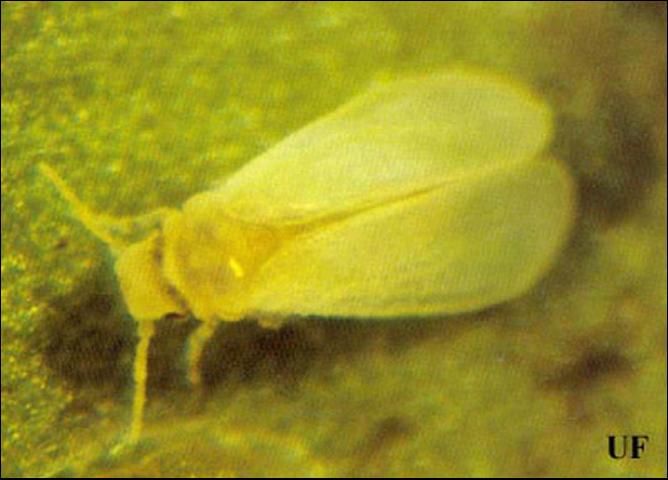The Featured Creatures collection provides in-depth profiles of insects, nematodes, arachnids and other organisms relevant to Florida. These profiles are intended for the use of interested laypersons with some knowledge of biology as well as academic audiences.
Introduction
The whitefly, Bemisia myricae, was described by Kuwana (1927) from Japan on the hosts Myrica rubra, Morus alba, and Citrus. Takahashi (1952) transferred this whitefly to the genus Parabemisia because of long marginal setae on the so-called "pupal" case and blunt lateral tubercles at the base of the lingula.
Bayberry whitefly was first discovered in the United States by California agriculture officials in 1978 (Rose et al. 1981), and in Florida by agriculture officials in early 1984 (Hamon 1986). Early dense populations caused defoliation in California citrus (Rose et al. 1981), but this has not happened in Florida. The early finds in Florida were under natural biological control by hymenopterous parasites, including Eretmocerus sp. Apparently the parasites were introduced with the whitefly. According to Mike Rose (personal communication), the Eretmocerus species present in Florida is the same as that found in California.
It was not until 1989 that any population in Florida was large enough to cause damage. This occurred in a nursery/greenhouse of the United States Sugar Corporation, Clewiston, Florida, on small citrus seedlings. A chemical control program was being carried out which eliminated the Eretmocerus sp., but not the bayberry whitefly. Outdoors, this whitefly is under biological control in Florida, and is only a problem in situations where natural balances are disturbed by the use of chemicals.
Distribution
This whitefly is only known from California and Florida in the United States. Foreign distribution includes China, Hong Kong, Israel, Japan, Taiwan, Malaysia, and Venezuela.
Description
The fourth nymphal skin has 30 to 32 marginal setae including the caudal setae. The anterior spiracular furrows are scarcely visible, but the caudal furrow is slightly ridged longitudinally. The vasiform orifice is elongate triangular with the lingula included. The lingula has two blunt lateral tubercles and two long caudal lingular setae. The operculum covers only the anterior one-third of the vasiform orifice. In vivo, the nymphs are surrounded by a marginal fringe of clear wax.

Credit: Division of Plant Industry
![Figure 2 Figure 2. Vasiform oriface [ a - linguala, b - operculum ] of the nymph of the bayberry whitefly, Parabemisia myricae (Kuwana)](/image/IN295/Dzh725ppwt/Dq40b6bnqq/Dq40b6bnqq-2048.webp)
Credit: Division of Plant Industry

Credit: Jeffrey Lotz, Division of Plant Industry
The adult is a small whitish-yellow moth-like insect that flits about when disturbed. The adults have a strong ovipositional preference for very young foliage in the "feather" stage (Walker & Aitken 1985). The adult will frequently place eggs along the leaf margin. At first, the eggs are white, but turn black in a few days.

Credit: Harold Browning, UF/IFAS
Hosts
Camellis sinensis, Chiococca alba, Citrus spp., Diospyros kaki, Elaeocarpus serratus, Ficus carica, Gardenia jasminoides, Machilus sp., Maesa japonica, Morus alba, Myrica rubra, Prunus mume, Prunus persica, Prunus triflora, Psidium guajava, Quercus serrata, Rhododendron sp., Salix babylonica, and Salix gracilistyla. The most favored hosts are Citrus spp. and gardenia.
Selected References
Hamon, A.B. 1986. Parabemisia myricae (Kuwana). p. 33. In 35th Biennial Report, Div. of Plant Industry. Florida Dept. Agric. and Cons. Serv.
Kuwana, I. 1927. On the genus Bemisia (Family Aleyrodidae) found in Japan, with description of new species. Annotnes Zool. Japan. 11: 245–253. (Not seen)
Mound, L.A., and S.H. Halsey. 1978. Whitefly of the world. A systematic catalogue of the Aleyrodidae (Homoptera) with host plant and natural enemy data. BM (NH) and John Wiley & Sons. Chichester. 340 p.
Rose, M., P. DeBach, and J. Woolley. 1981. Potential new citrus pest: Japanese bayberry whitefly. California Agric. 35: 22–24, illus.
Rose, M., and P. DeBach. 1982. A native parasite of bayberry whitefly. Citrography- October: 272–276.
Takahashi, R. 1952. Aleurotuberculatus and Parabemisia of Japan (Aleyrodidae: Homoptera). Misc. Rep. Res. Inst. Nat. Resour. Tokyo 25: 17–24.
Walker, G.P., and D.C.G. Aitken. 1985. Oviposition and survival of bayberry whitefly, Parabemisia myricae (Homoptera: Aleyrodidae) on lemons as a function of leaf age. Environ. Entomol. 14: 254–257.
Walker, G.P. 1987. Probing and oviposition behavior of the bayberry whitefly (Homoptera: Aleyrodidae) on young and mature lemon leaves. Ann. Entomol. Soc. America 80: 524–529.